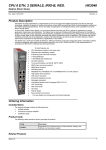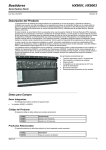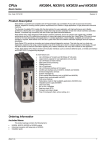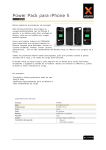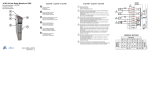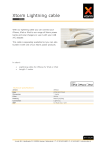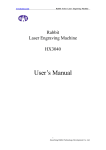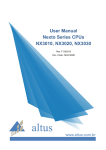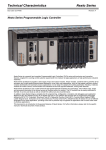Download Technical Characteristics
Transcript
Technical Characteristics Hadron Xtorm Series Doc.Code: CE123000 Revision: A Remote Terminal Unit Altus presents its solution for Generation, Transmission and Distribution of Electricity: the Hadron Xtorm Series. This series of Remote Terminal Units (RTUs) was designed based on international standards such as IEC 61850 protocol and IEC 61131-3 standard, promoting a revolutionary innovation in control, telemetry and supervision of power systems automation. Hadron Xtorm is a new generation of the consolidated Hadron Series, a product of Altus present for years in the Electric Energy market and with extensive installed base and diversity of applications. This product offers outstanding features such as redundant power supplies, redundant CPUs, IEC 61850 and DNP3 protocols (MMS and GOOSE) and attendance to the 2.7 ONS submodule, which refers to the requirements of telesupervision through digital event grouping for protection purposes. The architecture of the RTU provides a wide variety of input and output modules, which combined with a powerful 32-bit CPU and a high speed deterministic Ethernet-based, meet the requirements of many applications. Additionally, the series features a complete tool for configuring, programming, simulating and debugging user application: the MasterTool Xtorm. This document is an introduction to the general features of Hadron Xtorm Series. For more information, please refer to the specific manual or technical documentation for each product. Altus S.A. 1 Technical Characteristics Hadron Xtorm Series Doc.Code: CE123000 Revision: A Module List The complete list of modules can be seen below. For further information, please refer to the product documentation of each module. CPUs – Central Processing Units HX3040: High-speed CPU, 6 Ethernet ports, 2 serial channels, memory card interface, bus expansion support and redundancy support Input Modules HX1120: 125 Vdc 32 DI with Events Register Module HX6000: 16 AI Voltage/Current Module HX6020: 8 AI Temperature Module (RTD) Output Modules HX2320: 125 Vdc 16 DO Relay with CBO Module Altus S.A. Power Supply Modules HX8320: 60 W 125 Vdc Redundant Power Supply Racks HX9001: 9-position Rack HX9003: 18-position Rack Software HD8500/ADV: MasterTool Xtorm Advanced Accessories HX9102: Backplane Connector Cover HX9405: 04-terminal Connector HX9401: 06-terminal Connector HX9402: 10-terminal Connector NX9202: RJ45-RJ45 2 m Cable NX9205: RJ45-RJ45 5 m Cable NX9210: RJ45-RJ45 10 m Cable NX9101: 8 GB microSD card with SD adapters e miniSD 2 Technical Characteristics Hadron Xtorm Series Doc.Code: CE123000 Revision: A Innovative Features Hadron Xtorm Series brings to the user several innovations in utilization, supervision and system maintenance. These features were developed focusing a new experience in hydroelectric power plants and substations. The list below shows some of these new features that users will find in the Hadron Xtorm Series: Battery Free Operation: Hadron Xtorm Series does not require any kind of battery for memory maintenance and real time clock operation. This feature is extremely important because it reduces the system maintenance needs and allows the use in remote locations where maintenance can be difficult to be performed. Besides, this feature is environmentally friendly. Multiple Block Storage: Several kinds of memories (volatile and non-volatile) are available to the user in Hadron Xtorm Series CPUs, offering the best option for any user needs. The Hadron Xtorm Series CPUs offer addressable input variables (%I), addressable output variables (%Q), data memory and symbolic variables. For applications that require non-volatile functionality, Hadron Xtorm Series allows the use of retain addressable memory variables (%Q), data retain memory, symbolic variables, persistent data memory, program memory, source code memory, CPU file system (DOC files, PDF, images, data, among others) and memory card interface. One Touch Diag: This feature Hadron Xtorm Series feature allows the user to check diagnostic information of any module present in the system directly on the graphic display with one single press in the diagnostic switch. It is a powerful diagnostic tool that can be used offline reducing maintenance and commissioning times. OFD – On Board Full Documentation: Hadron Xtorm Series CPUs are capable of storing the complete project documentation in its own memory. This feature is used for backup purposes and maintenance, since the complete information is stored in a single and reliable place. ETD – Electronic Tag on Display: This feature allows the checking the tag of any I/O pin or module used in the system directly on the CPU’s graphic display. Along with this information, the user can check the description, as well. This feature is extremely useful during maintenance and troubleshooting procedures Altus S.A. 3 Technical Characteristics Hadron Xtorm Series Doc.Code: CE123000 Revision: A Architecture The Remote Terminal Unit (RTU) of the Hadron Xtorm Series is a modular solution with flexible configuration, composed by multiple processors. It offers several options of communication protocols and input and output modules, enabling its use in applications with a large number of I/O points. CPU The CPU presents several integrated functions, online programming, high memory capacity, six Ethernet ports, two serial channels, an input and output port to the time sync signal. The six Ethernet ports are available for programming and configuration, use in IEC 61850/DNP3/MODBUS TCP networks and embedded web server. In addition, the CPUs have two serial interfaces for connection of local HMIs and use in MODBUS RTU networks, a memory card slot for application source code storage and program update, two ports to receive and send the IRIG-B time sync signal, making possible the time synchronization of other equipment. Power Supply Module The power supply module provides power to the modules installed in the racks. Each rack must have its own module. If there is a need for high availability, the system can operate with two redundant modules, if a module fails; the standby unit will keep the system active until maintenance. The current consumption of the application modules are shown in the configuration tool and must comply with the maximum capacity of the Power Supply Module. In addition, this module has the bus expansion feature, where through two RJ45 ports located on the front of the module it is possible to connect the main rack with other inputs and outputs in remote racks. Each HX8320 module contains two keys to select the rack address, which must be unique on a system. High-speed bus With a modern deterministic Ethernet-based bus, the Hadron Xtorm Series architecture introduces high throughput, allowing the update of vast amounts of points in a short period of time. In addition, the new technology enables the achievement of time-critical applications. The modules are addressed and identified automatically, avoiding mistakes during the application configuration and maintenance in the field. The bus provides special features that enable CPU and power supply redundancy in the same rack. It is also possible to implement a mixed architecture using the Hadron Xtorm Series bus expansion to interconnect with a Nexto Series rack. In this case, only a rack with input/output and bus expansion modules of Nexto Series may be used. I/O Modules The I/O modules are connected in the racks for the acquisition and activation of different types of field signals and to interface with the CPU. The Hadron Xtorm Series supports a wide variety of I/O types and ranges of operation, assuring the typical needs of an automation system of electric power generation plants and substations. The I/O modules, among other features, include 1 ms event log functionality, the double point mapping and the "Check Before Operate" (CBO), which consists of a logic that allows the user to detect failure in the output circuits, monitoring them before driving action. The I/O modules in the Hadron Xtorm Series also support hot swap, i.e. they can be disconnected without necessarily disable the system or remove power. Racks The racks feature a special aluminum chassis, with a printed circuit board, where all modules are connected. The racks design combine high immunity against electromagnetic interference and electrostatic discharge (ESD) (if recommended ground rules are performed during the installation phase), robustness and optimized use of the internal space of electrical panels. Altus S.A. 4 Technical Characteristics Hadron Xtorm Series Doc.Code: CE123000 Revision: A Application Examples Below we can see an example of typical architecture using the Remote Terminal Unit (RTU) Hadron Xtorm Series. CPU with Local I/O This architecture is based on a single rack, called local rack. This rack consists of a CPU, a power supply module and the I/O modules required for the application, as shown below. The order of the modules should follow the configuration rules presented in the configuration tool. This architecture is designed for small applications, where there are a low number of I/O points. CPU with Remote I/O (Bus Expansion) This architecture is designed for medium and large applications, where there are a high number of I/O points. Altus S.A. 5 Technical Characteristics Hadron Xtorm Series Doc.Code: CE123000 Revision: A This architecture is based on a main rack (where the CPU is located) and remote racks. The communication between the local and remote racks is made through the extension ports, located in the HX8320 module. Each remote rack requires its own power supply module. The HX8320 module has two RJ45 ports, one being used for the input data and the other one for the output data. In this application example, only the output port of the local HX8320 module is connected, leaving the input data port opened. On the other hand, in the last remote rack, is the output data port that stays open. The intermediate remote racks present both connected ports: a port connected to the previous rack and the other one to the next rack. This architecture is designed for medium and large applications with high number of I/O points. Altus S.A. 6 Technical Characteristics Hadron Xtorm Series Doc.Code: CE123000 Revision: A CPU with Remote I/O (Bus Expansion with Loopback) In the same way, as the previous one, this architecture is based on a local rack (where the CPU is located) and remote racks. The communication between the local and remote racks is made through the extension ports, located in the HX8320 module. The only difference compared to the previous architecture, is that the output data port of the last remote rack is connected to the main rack input data port. This architecture allows the system to maintain access to remote racks information even in the event of a failure in the extension cables. The CPU detects the simple failure in one of the cables and redirects internal data paths to support this failure. In this case, will also be generated a diagnostic alarm for the user. This feature has advantages in the case of cables maintenance with the system energized, in addition to increasing system availability. The figure below illustrates this architecture. Altus S.A. 7 Technical Characteristics Hadron Xtorm Series Doc.Code: CE123000 Revision: A CPU with Remote I/O and High Availability (Bus Expansion Redundancy with Loopback) This architecture is based on the use of two HX8320 modules per rack. Relying on two bus expansion modules, the system features a high availability as it supports failure in bus expansion cables or in the HX8320 module itself. Similarly to the previous architecture, this one is intended for systems where the maintenance is critical and the system needs to be available for extended periods. In this architecture, the racks must be mounted in accordance with the diagram below, with HX8320 modules located side by side in early positions of the rack. Note that there are expansion bus modules with unused ports, which should be left disconnected. Altus S.A. 8 Technical Characteristics Hadron Xtorm Series Doc.Code: CE123000 Revision: A CPU and Power Supply Module Redundancy For critical applications, the Hadron Xtorm Series offers redundancy of CPUs and power supply modules in the same rack, and when the user chooses to use redundancy of CPUs in its architecture, he should also use redundancy of power supply modules. In this architecture, the system will have a CPU running the task of control (active) and another remaining in reserve, in a hotstandby topology. In the event of a failure of the active CPU, the system will automatically perform a switchover (event where the CPU in reserve becomes active). This means that critical applications are not affected by any failure of the control system, ensuring high availability for these applications. The results are increased efficiency, productivity, minimizing downtime and less maintenance time. The configuration of the two CPUs must be identical. The active CPU and the reserve CPU should be in rack positions that support such functionality (rack position 3 and 4). This application is easy to configure and needs no special programming or parameterization. For the redundancy of the power supply module, if one of the modules fails, automatically, the second one will becomes active. In each module there will be an indication of his condition and the input voltage. This state can be used to detect and replace the failed module. This status can be read by the CPU via the bus and reported to the monitoring devices such as operation terminal or man-machine Interface (HMI) or a supervisory system and data acquisition (SCADA). A module in failure can be replaced during normal operation of the system, without the need of power down or application interruption. Altus S.A. 9 Technical Characteristics Hadron Xtorm Series Doc.Code: CE123000 Revision: A Time Sync via IRIG-B For applications where time synchronism with other equipment is necessary, the Hadron Xtorm Series CPU has an input port and an output port to the IRIG-B signal. Through the input port, the CPU will receive the time sync data and sync with its internal clock. And through the output port, the CPU can synchronize other devices, retransmitting on the output port, the signal received at the input port. Altus S.A. 10 Technical Characteristics Hadron Xtorm Series Doc.Code: CE123000 Revision: A For applications where CPU redundancy is used, it is appropriate that the time sync signal be connected to each one of the CPUs, regardless of which CPU is in active mode and reserve mode, thus ensuring the system time sync. In the figure below we can see an example of this type of architecture. Altus S.A. 11 Technical Characteristics Hadron Xtorm Series Doc.Code: CE123000 Revision: A Ethernet Redundant Networks with NIC Teaming Each CPU can have one or more network protocols configured for communication with the control center or other equipment or field devices. For Ethernet network redundancy with NIC Teaming, it is necessary that two CPU Ethernet ports are configured in a redundant pair. A set of two Ethernet ports forming a NIC Teaming pair implies a single IP address linked to both ports. In this way, the control center needs not worry about changing the IP if there is failure in any of the ports of the NIC Teaming pair. Each one of the Ethernet ports must be connected to different switches. If one of the ports fails, automatically the data packets will be redirected to the other port. This Ethernet architecture enables high availability system communication, being strongly indicated to overcome failures in the Ethernet ports, cables and switches. Altus S.A. 12 Technical Characteristics Hadron Xtorm Series Doc.Code: CE123000 Revision: A Ethernet Networks in Ring Mode There is a mode of operation that transforms a pair of Ethernet interfaces in a switch, where communication can be performed by both ports. This allows a ring network topology implementation. In this ring, it is necessary to include an external switch with ability to manage it, to avoid the occurrence of loops that degrade network performance. All Ethernet interfaces have individual diagnoses, facilitating debugging problems. Altus S.A. 13 Technical Characteristics Hadron Xtorm Series Doc.Code: CE123000 Revision: A Compatibility with Other Products The Hadron Xtorm series has compatibility with all versions of MasterTool Xtorm, with bus expansion support, carried out through the HX8320 module. With the HX3040 CPU model it is possible to expand the architecture for up to 8 racks (main rack + 8 expansion racks) using bus expansion functionality. In this case, the maximum number of modules among all expansion racks may not exceed 64. It is also possible to mount a mixed architecture using the Hadron Xtorm series expansion bus to interconnect with a Nexto series rack. In this case, only one rack with I/O modules and a Nexto series bus expansion module can be used. The figure below shows this architecture. ATTENTION: For a mixed architecture, only Nexto Series I/O modules are allowed. The other modules of Nexto Series cannot be installed in mixed expansion buses of Hadron Xtorm Series. Altus S.A. 14 Technical Characteristics Hadron Xtorm Series Doc.Code: CE123000 Revision: A Physical Dimensions The dimensions of the main modules are shown below in mm. Racks 9-position Rack 18-position Rack Altus S.A. 15 Technical Characteristics Hadron Xtorm Series Doc.Code: CE123000 Revision: A Modules This size of module is used by all other modules in the Hadron Xtorm Series. The figure illustrates the HX3040 CPU. Main Features Robustness The Hadron Xtorm Series design is extremely robust and allows the use in applications with hostile environments. Able to be installed in environments with presence of mechanical vibration and extended operation temperature, the series is qualified for applications in power plants, in power rooms or near large floodgates. Finally, it has high requirements for immunity to electrostatic discharge and electromagnetic noises commonly present in these applications. Its design offers these possibilities, without compromise of installation procedures and maintenance. Hot swap The hot swap feature allows the replacement of modules without de-energizing the system. The CPU keeps track of the entire process and modules can be replaced whenever necessary. High Availability The series offers several redundancy architectures, where CPUs and power supplies can be configured in an application. With this flexibility the system can be adjusted from simple systems, without any redundancy, even complex and critical applications where high availability is essential. Advanced Diagnostics Altus S.A. 16 Technical Characteristics Hadron Xtorm Series Doc.Code: CE123000 Revision: A Each module contains its own diagnostics: the CPUs, power supplies and I/O modules have multiple diagnostics available. Each module has a multifunctional display that informs user its state. In addition, each module has a button on its front to provide information of different diagnoses for the maintenance team. These diagnoses can be monitored in the field through displays or through the configuration tool. Some examples are: Module located in an incorrect position on the rack Absence of power supply Outputs short circuit There is no configuration for a module that needs to be configured for normal operation Tag visualization and I/O description on Remote Terminal Unit IP address visualization Capabilities In Hadron Xtorm Series a single CPU can control 512 I/O points using only one rack. It is possible to expand to as many as 9 racks (main rack + 8 expansion racks) using the bus expansion feature. In this case, the maximum number of modules present on all racks cannot be greater than 64. CPU Programming & Firmware Update The Hadron Xtorm Series allows CPU programming and firmware update via CPU Ethernet ports. This approach offers some features, such as: Multifunctional Ethernet ports used to share programming, peer-to-peer data exchange, third part device protocol in the application layer, network variables data exchange, etc. Direct access to CPU local variables Remote access Firmware update Software Characteristics HD8500 – MasterTool Xtorm The MasterTool Xtorm is the software for configuring, programming, simulating, monitoring and debugging of Hadron Xtorm Series. Based on the concept of integrated tool, the MasterTool Xtorm provides flexibility and ease of use, allowing users to import data of electronic spreadsheets for parameterization of modules or variables mapping in communication protocols available in the CPU. Among the protocols and integrated services, the tool includes MODBUS RTU, MODBUS TCP, DNP3, and IEC 61850 (MMS Server and GOOSE), time sync, besides the events grouping that can be accomplished in graphic form. The MasterTool Xtorm also offers all editors defined in IEC 61131-3 for application development: Structured Text (ST), Sequential Function Chart (SFC), Function Block Diagram (FBD), Ladder Diagram (LD), Instruction List (IL) and Continuous Function Chart (CFC). All editors have been specially developed to ensure great choice for users depending on the application, the user profile and technical culture in automation. Key features: Programming languages based on IEC 61131-3 Graphic editors for project configuration and hardware Object-oriented programming Simulation User documentation and help files integrated Advanced diagnostics Visualization that uses the concept of tabs (Docking View) Integration of Logical Nodes (IEC 61850) with the IEC 61131-3 programming language Library of functions for hydroelectric power plants and substations Altus S.A. 17 Technical Characteristics Hadron Xtorm Series Doc.Code: CE123000 Revision: A IEC 61131-3 Programming Languages The MasterTool Xtorm offers all editors defined in IEC standard for application development: Structured Text (ST), Sequential Function Chart (SFC), Function Block Diagram (FBD), Ladder Diagram (LD), Instruction List (IL) and Continuous Function Chart (CFC). The editor allows the declaration and use of symbolic variables, and the variables are integrated in all editors. All editors have been specially developed to ensure optimum management. Ideas and suggestions from experienced users have been incorporated into the development process. Some examples: When working in FBD, LD or IL, the user can switch between these editors Language elements can be entered directly or dragged into the editor from a Toolbox The HD8500 offers a smart entry Wizard and AutoComplete functionality Typical language constructions (IF statements, FOR loops, variables, classes, etc.) can be hidden in textual editors Language constructs are automatically created (IF ... END_IF) The SFC editor can be used as defined in standard or in a simplified version A suitable time for monitoring steps and for online diagnosis functionality is also available in the SFC editor Steps and transitions in the SFC editor and all elements in the CFC editor can be encapsulated in macros Editors for Project and Hardware Configuration With the help of special editors, a project can be easily configured in MasterTool Xtorm. The graphical tool allows a quick and friendly way of configuring the system. Additionally, the user has full view of the architecture of the application physical position and the information from each module. The configuration of network interfaces and standard communication protocols such as MODBUS, DNP3 and IEC 61850 are integrated in the programming tool. This feature allows the user to set all configuration parameters in a single place, not needing to use different software tools. If necessary, the user can use the feature of data import from spreadsheets for parameterization, recovery or comparison of projects mappings tables by selecting and dragging the tables from spreadsheets to editors' configuration tabs. Object Oriented Programming The MasterTool Xtorm offers an object-oriented programming with the known advantages of modern high-level languages, such as JAVA or C++: classes, interfaces, methods, inheritance, polymorphism, etc. Object-oriented programming offers great advantages to the user, such as for example, when you want to reuse existing parts of an application, or when working on an application with several developers. Altus S.A. 18 Technical Characteristics Hadron Xtorm Series Doc.Code: CE123000 Revision: A Online, Debugging and Commissioning Features The generated code from the application is sent to the device with a single click of mouse. From the moment the MasterTool Xtorm is online, are available several important functions to perform a debug quickly and efficiently, as well as for testing and commissioning. The values of the variables declared, for example, are displayed in the program code. These values can be changed or forced without any difficulty. By setting breakpoints and stepping through them in the code line (step by step) the errors can be easily detected. Breakpoints, in MasterTool Xtorm, may also be assigned to certain conditions in order to give more precision to the debugging process. In a single cycle operation, the user can follow the application execution through a complete cycle. If the application is modified, the modifications will be compiled, loaded and then activated, without the need to interrupt controller and without the risk of loss of the variables values. Are also possible changes to several POUs (Program Organization Units), variables or data types. This feature is called Online change. The Trace feature is a powerful tool that allows the user to analyze application data in graphic form, enabling obtaining information as trends and temporal dynamics of application data. Simulation A feature that allows the user to evaluate and test various logics and algorithms is the simulation tool. This feature allows user applications to be designed and tested without the need of a RTU connected. This is also interesting for training, documentation and evaluation of test cases. As this is a simulator, naturally there may be some limitations in the application development compared to the real RTU. User documentation & Help Files Whereas the Remote Terminal Unit programming according to IEC 61131-3 standard languages is a complex task, the MasterTool Xtorm offers an extensive help file with various tips and descriptions to guide and serve as a first base troubleshooting data for the user, in the creation of logical codes or the use of the software features. This help file is available in different languages, according to the installation options. The MasterTool Xtorm also supports multiple languages, allowing the user to select your preferred language from the available options. As part of the user documentation, the HD8500 can print application documents such as bills of materials (BOM), POUs and configuration parameters. Advanced Diagnostics One of the innovations of the Hadron Xtorm Series is its extensive support of diagnostics. This idea emerged from the demands of extensive and complex applications, where the correct use of each piece of information is fundamental to the maintenance, prevention and resolution of potential problems. This feature is also present in the MasterTool Xtorm where the user, while connected to a running CPU, will be able to access complete diagnostic structures through monitoring windows and web pages. Docking View Docking View technology allows the user to customize the MasterTool Xtorm environment, according to your personal needs. This feature provides a friendly user interface to maximize the experience with the software tool. Altus S.A. 19 Technical Characteristics Hadron Xtorm Series Doc.Code: CE123000 Revision: A Integration of Logical Nodes with the IEC 61131-3 programming languages In the Mastertool Xtorm, for each logical node (LN) of IED configuration, assigned to the user project, the corresponding function block is automatically declared in the development environment of the user logic. Configuration details, descriptions and operation of LNs are described in the Hadron Xtorm Series User Manual. However, it is recommended the reading of standard IEC 61850 for best use of logic presented. Environmental Conditions Hadron Xtorm Series modules are in accordance with the following environmental specifications: Storage temperature -25 to 85 °C Operating temperature -5 to 60 °C Storage and operating relative humidity Standards 5 to 96 %, non-condensing IEC 61131-2 IEC 61131-3 CE, Electromagnetic Compatibility (EMC) and LowVoltage Directive (LVD) RoHS Directive Altus S.A. 20 Technical Characteristics Hadron Xtorm Series Doc.Code: CE123000 Revision: A Manuals For further technical details, configuration, installation and programming of Hadron Xtorm Series the table below should be consulted. The complete and updated table containing all documents of Hadron Xtorm Series can be found at the Hadron Xtorm User Manual – MU223600. Altus S.A. Document code Description Language MU223000 MU223600 MU223300 Manual de Utilização Hadron Xtorm Hadron Xtorm User Manual Manual Del Usuario Hadron Xtorm Portuguese English Spanish 21





















